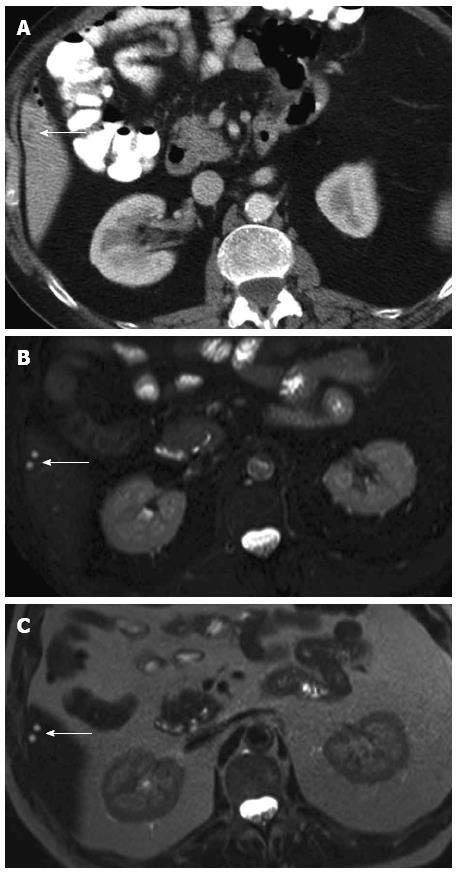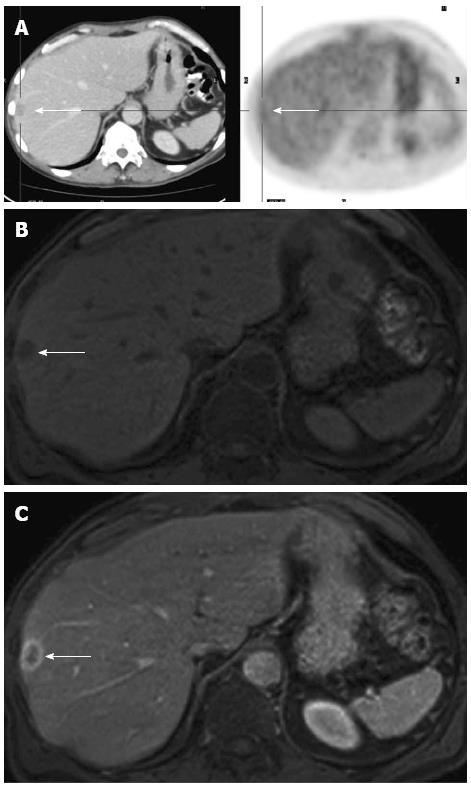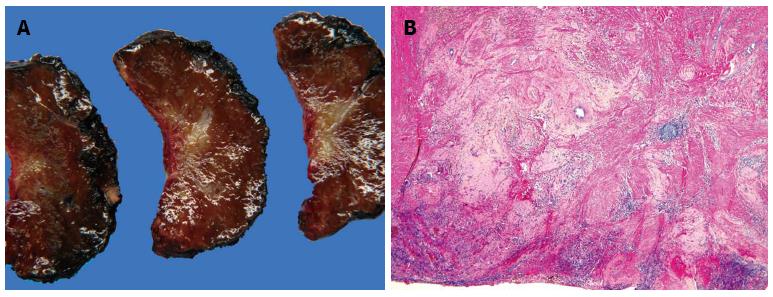Copyright
©2013 Baishideng Publishing Group Co.
World J Gastroenterol. Feb 28, 2013; 19(8): 1152-1157
Published online Feb 28, 2013. doi: 10.3748/wjg.v19.i8.1152
Published online Feb 28, 2013. doi: 10.3748/wjg.v19.i8.1152
Figure 1 Example of a small lesion which proved to be benign after follow-up.
A: Two small (< 10 mm) indeterminate focal liver lesions (white arrow) on contrast-enhanced computed tomography; B: Corresponding magnetic resonance imaging (MRI), images showing a T2w Turbo Spin Echo sequence with fat suppression. Two clearly hyperintense focal liver lesions (white arrow) are displayed compatible with simple liver cysts; C: Corresponding MRI images showing a T2w Turbo Spin Echo sequence without fat suppression. Two clearly hyperintense focal liver lesions (white arrow) are displayed compatible with simple liver cysts.
Figure 2 Example of a small lesion which proved to be malignant after follow-up.
A: Positron emission tomography (PET)/computed tomography negative (PET-cold) focal liver lesion (white arrow) in a patient who received chemotherapy in the past; B: Corresponding T1w Gradient Echo magnetic resonance imaging (MRI) image before injection of contrast agent shows a rather hypo-intense focal liver lesion (white arrow); C: Corresponding T1w Gradient Echo MRI image in the venous phase after injection of contrast agent shows a hypo-intense focal liver lesion with ring-enhancement compatible with an (active) malignant focal liver lesion (colorectal cancer liver metastasis) (white arrow).
Figure 3 Restaging the liver after neoadjuvant therapy in a patient with multiple liver metastases from rectal cancer.
A: On computed tomography (CT) before intravenous contrast, all the metastases disappeared except for a small lesion suspicious of residual disease (white arrow); B: Corresponding CT after intravenous contrast showing the challenging lesion (white arrow); C: Also on magnetic resonance imaging the lesion (white arrow) remains suspicious for malignancy providing indication for a liver resection.
Figure 4 Pathological examination of the resected liver specimen corresponding to the lesion indicated by the white arrow in figure 3.
A: Gross specimen: on cut the macroscopic examination shows a star-like whitish lesion; B: At histology (hematoxylin and eosin, x 100) only fibrosis and inflammation are seen indicating a complete response to chemotherapy.
- Citation: Puppa G, Poston G, Jess P, Nash GF, Coenegrachts K, Stang A. Staging colorectal cancer with the TNM 7th: The presumption of innocence when applying the M category. World J Gastroenterol 2013; 19(8): 1152-1157
- URL: https://www.wjgnet.com/1007-9327/full/v19/i8/1152.htm
- DOI: https://dx.doi.org/10.3748/wjg.v19.i8.1152












